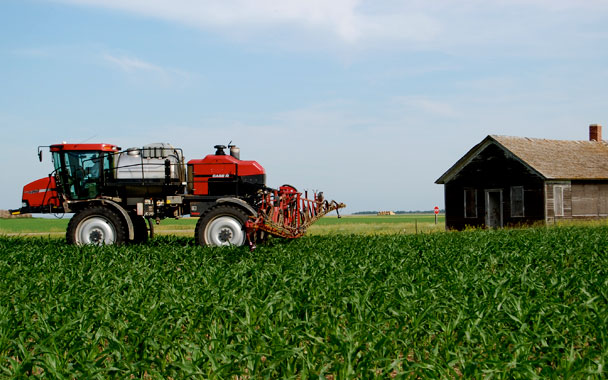Exhaustion breeds indifference. Everyone in eastern South Dakota is tired of talking about the weather. A tornado rumbled through last week, 30 miles west of Dale Hargens, and he doesn’t even mention it. He has just finished two solid weeks of sunrise-to-sunset wheat combining. He’s tired and happy. He still thinks his best cornfields will yield a record 200 bushels an acre, and overall the farm will average 150 bushels. “The beans look fabulous. Fifty bushels an acre. Those are Iowa yields.” It’s time to take a few days off. He’s going to Mitchell to the farm show. “Just looking,” he says. “Like a kid in a toy store just before Christmas. I’ve got a wish list. Maybe some new heads for the combine and some harvest equipment.”
Up in Brown County, Scott Christenson is mowing weeds around the edges of his fields and trying to find time for a few rounds of golf. “Once we get past Labor Day, there won’t be any time to relax. We’ll be getting into the corn harvest,” he says.
In the midst of the calm, two headlines hit the newspapers, illustrating the great paradox of industrial commodity farming on the Great Plains.
Marine biologists announce that the “dead zone” in the Gulf of Mexico is 8,500 square miles. Nothing can live in the oxygen-starved waters of the dead zone: no seafood, no nothing. The dead zone has strangled the seafood economy of the Louisiana and Texas coasts and destroyed the region’s ecological diversity. The cause? High nitrogen-fertilizer runoff from the agricultural lands of the sprawling Mississippi River floodplain. From Crow Creek and Wolf Creek into the James River, into the Missouri, and down the Mississippi to the Gulf of Mexico. Even The New York Times steps in to editorialize that “there is no better symbol of the paradox of American agriculture—the very richness applied to the fields is the source of ecological death hundreds of miles away.” Hargens is quick to explain that his high yields are the result of being “very aggressive” about fertilizer applications and pesticide control. But he has no way of calculating his contribution to the dead zone, and federal farm policy offers neither incentives to farm a different way, nor sanctions to slow down or limit his use of fertilizer. He makes individual choices about his private farmland disconnected from the public consequences almost 1,500 miles away.




 Pinterest
Pinterest


